Photon Spheres, ISCOs, and OSCOs: Astrophysical Observables for Regular Black Holes with Asymptotically Minkowski Cores
Abstract
1. Introduction
2. Geodesics and the Effective Potential
3. Photon Spheres
3.1. Existence of Photon Spheres
3.2. Stability versus Instability for Circular Photon Orbits
3.2.1. Perturbative Analysis (small a)
3.2.2. Non-Perturbative Analysis
3.3. Turning Points
4. Timelike Circular Orbits
4.1. Existence of Circular Timelike Orbits
4.2. Stability versus Instability for Circular Timelike Orbits
4.2.1. Perturbative Analysis (Small a)
4.2.2. Non-Perturbative Analysis
4.3. Intersection of ESCO and Photon Sphere
4.4. Explicit Result for the Angular Momentum
4.5. Summary
- For , we have an ESCO.This ESCO then subdivides as follows:
- -
- For , we have an ISCO.
- -
- For , we have an OSCO.
- For , the stability region is bounded by a stable photon orbit.
- The line bounds the stability and existence region for timelike circular orbits from below.
5. Conclusions
Author Contributions
Funding
Conflicts of Interest
Abbreviations
| ESCO | Extremal stable circular orbit |
| ISCO | Innermost stable circular orbit |
| OSCO | Outermost stable circular orbit |
| CMO | Compact massive object |
References
- Schwarzschild, K. Über das Gravitationsfeld eines Massenpunktes nach der Einsteinschen Theorie. Sitzungsberichte Der KÖniglich Preuss. Akad. Der Wiss. 1916, 7, 189. [Google Scholar]
- Reissner, H. Über die Eigengravitation des elektrischen Feldes nach der Einsteinschen Theorie. Ann. Der Phys. 1916, 50, 106. [Google Scholar] [CrossRef]
- Weyl, H. Zur Gravitationstheorie. Ann. Der Phys. 1917, 54, 117. [Google Scholar] [CrossRef]
- Nordström, G. On the Energy of the Gravitational Field in Einstein’s Theory. Verhandl. Koninkl. Ned. Akad. Wetenschap. Afdel. Natuurk. 1918, 24, 1201. [Google Scholar]
- Kerr, R. Gravitational Field of a Spinning Mass as an Example of Algebraically Special Metrics. Phys. Rev. Lett. 1963, 11, 237. [Google Scholar] [CrossRef]
- Newmann, E.; Couch, E.; Chinnapared, K.; Exton, A.; Prakash, A.; Torrence, R. Metric of a Rotating, Charged Mass. J. Math. Phys. 1965, 6, 918. [Google Scholar] [CrossRef]
- Kerr, R.; Schild, A. Republication of: A new class of vacuum solutions of the Einstein field equations. Gen. Rel. Grav. 2009, 41, 2485. [Google Scholar] [CrossRef]
- Visser, M. The Kerr spacetime: A brief introduction. arXiv 2007, arXiv:0706.0622. [Google Scholar]
- Wiltshire, D.L.; Visser, M.; Scott, S.M. The Kerr Spacetime: Rotating Black Holes in General Relativity; Cambridge University Press: Cambridge, UK, 2009. [Google Scholar]
- Baines, J.; Berry, T.; Simpson, A.; Visser, M. Unit-lapse versions of the Kerr spacetime. arXiv 2008, arXiv:2008.03817. [Google Scholar]
- Baines, J.; Berry, T.; Simpson, A.; Visser, M. Painleve-Gullstrand form of the Lense-Thirring spacetime. arXiv 2006, arXiv:2006.14258. [Google Scholar]
- Vaidya, P.C. The External Field of a Radiating Star in General Relativity. Curr. Sci. (India) 1943, 12, 183. [Google Scholar] [CrossRef]
- Vaidya, P.C. The external field of a radiating star. Proc. Indian Acad. Sci. 1951, 33, 264. [Google Scholar] [CrossRef]
- Vaidya, P.C. Nonstatic solutions of Einstein’s field equations for spheres of fluids radiating energy. Phys. Rev. 1951, 83, 10. [Google Scholar] [CrossRef]
- Calmet, X. Quantum Aspects of Black Holes; Springer Int. Pub.: Heidelberg, Germany, 2015. [Google Scholar]
- Calmet, X.; El-Menoufi, B.K. Quantum corrections to Schwarzschild black hole. Eur. Phys. J. C 2017, 77, 243. [Google Scholar] [CrossRef]
- Kazakov, D.I.; Solodukhin, S.N. On quantum deformation of the Schwarzschild solution. Nucl. Phys. B 1994, 429, 153. [Google Scholar] [CrossRef]
- Ali, A.F.; Khalil, M.M. Black hole with quantum potential. Nucl. Phys. B 2016, 909, 173. [Google Scholar] [CrossRef]
- Bardeen, J.M. Non-singular general-relativistic gravitational collapse. In Proceedings of the International Conference GR5, Tbilisi, Georgia, USSR, 9–13 September 1968. [Google Scholar]
- Hayward, S.A. Formation and Evaporation of Nonsingular Black Holes. Phys. Rev. Lett. 2006, 96, 031103. [Google Scholar] [CrossRef]
- Frolov, V.P. Information loss problem and a ‘black hole’ model with a closed apparent horizon. J. High Energy Phys. 2014, 2014, 49. [Google Scholar] [CrossRef]
- Ansoldi, S. Spherical black holes with regular center: A review of existing models including a recent realization with Gaussian sources. arXiv 2008, arXiv:0802.0330. [Google Scholar]
- Carballo-Rubio, R.; di Filippo, F.; Liberati, S.; Pacilio, C.; Visser, M. On the viability of regular black holes. J. High Energy Phys. 2018, 2018, 20. [Google Scholar] [CrossRef]
- Morris, M.; Thorne, K.S. Wormholes in spacetime and their use for interstellar travel: A tool for teaching General Relativity. Am. J. Phys. 1988, 56, 395. [Google Scholar] [CrossRef]
- Morris, M.S.; Thorne, K.S.; Yurtsever, U. Wormholes, Time Machines, and the Weak Energy Condition? Phys. Rev. Lett. 1988, 61, 1446. [Google Scholar] [CrossRef] [PubMed]
- Visser, M. Lorentzian Wormholes: From Einstein to Hawking; Springer: New York, NY, USA, 1995. [Google Scholar]
- Visser, M. Traversable wormholes: Some simple examples. Phys. Rev. D 1989, 39, 3182. [Google Scholar] [CrossRef] [PubMed]
- Visser, M. Traversable wormholes from surgically modified Schwarzschild space-times. Nucl. Phys. B 1989, 328, 203–212. [Google Scholar] [CrossRef]
- Visser, M. Wormholes, Baby Universes and Causality. Phys. Rev. D 1990, 41, 1116. [Google Scholar] [CrossRef]
- Visser, M.; Kar, S.; Dadhich, N. Traversable wormholes with arbitrarily small energy condition violations. Phys. Rev. Lett. 2003, 90, 201102. [Google Scholar] [CrossRef]
- Visser, M. From wormhole to time machine: Comments on Hawking’s chronology protection conjecture. Phys. Rev. D 1993, 47, 554–565. [Google Scholar] [CrossRef]
- Kar, S.; Dadhich, N.; Visser, M. Quantifying energy condition violations in traversable wormholes. Pramana 2004, 63, 859–864. [Google Scholar] [CrossRef]
- Poisson, E.; Visser, M. Thin shell wormholes: Linearization stability. Phys. Rev. D 1995, 52, 7318–7321. [Google Scholar] [CrossRef]
- Cramer, J.G.; Forward, R.L.; Morris, M.S.; Visser, M.; Benford, G.; Landis, G.A. Natural wormholes as gravitational lenses. Phys. Rev. D 1995, 51, 3117–3120. [Google Scholar] [CrossRef]
- Dadhich, N.; Kar, S.; Mukherji, S.; Visser, M. R=0 space-times and selfdual Lorentzian wormholes. Phys. Rev. D 2002, 65, 064004. [Google Scholar] [CrossRef]
- Boonserm, P.; Ngampitipan, T.; Simpson, A.; Visser, A. The exponential metric represents a traversable wormhole. Phys. Rev. D 2018, 98, 084048. [Google Scholar] [CrossRef]
- Simpson, A.; Visser, M. Black-bounce to traversable wormhole. JCAP 2019, 1902, 42. [Google Scholar] [CrossRef]
- Simpson, A.; Martín-Moruno, P.; Visser, M. Vaidya spacetimes, black-bounces, and traversable wormholes. Class. Quant. Grav. 2019, 36, 145007. [Google Scholar] [CrossRef]
- Lobo, F.S.N.; Simpson, A.; Visser, M. Dynamic thin-shell black-bounce traversable wormholes. Phys. Rev. D 2020, 101, 124035. [Google Scholar] [CrossRef]
- Mazur, P.O.; Mottola, E. Gravitational vacuum condensate stars. Proc. Natl. Acad. Sci. USA 2004, 101, 9545. [Google Scholar] [CrossRef]
- Mazur, P.O.; Mottola, E. Gravitational Condensate Stars: An Alternative to Black Holes. arXiv 2001, arXiv:0109035. [Google Scholar]
- Visser, M.; Wiltshire, D. Stable gravastars: An alternative to black holes? Class. Quant. Grav. 2004, 21, 1135. [Google Scholar] [CrossRef]
- Cattoën, C.; Faber, T.; Visser, M. Gravastars must have anisotropic pressures. Class. Quant. Grav. 2005, 22, 4189–4202. [Google Scholar] [CrossRef]
- Lobo, F.S.N. Stable dark energy stars. Class. Quant. Grav. 2006, 23, 1525. [Google Scholar] [CrossRef]
- Martín-Moruno, P.; Montelongo-García, N.; Lobo, F.S.N.; Visser, M. Generic thin-shell gravastars. JCAP 2012, 3, 34. [Google Scholar] [CrossRef]
- Lobo, F.S.N.; Martín-Moruno, P.; Montelongo-García, N.; Visser, M. Novel stability approach of thin-shell gravastars. arXiv 2015, arXiv:1512.07659. [Google Scholar]
- Cunha, P.V.; Berti, E.; Herdeiro, C.A.R. Light-Ring Stability for Ultracompact Objects. Phys. Rev. Lett. 2017, 119, 251102. [Google Scholar] [CrossRef] [PubMed]
- Cunha, P.V.; Herdeiro, C.A.R. Stationary black holes and light rings. Phys. Rev. Lett. 2020, 124, 181101. [Google Scholar] [CrossRef] [PubMed]
- Carballo-Rubio, R.; di Filippo, F.; Liberati, S.; Visser, M. Opening the Pandora’s box at the core of black holes. Class. Quant. Grav. 2020, 37, 145005. [Google Scholar] [CrossRef]
- Visser, M.; Barceló, C.; Liberati, S.; Sonego, S. Small, dark, and heavy: But is it a black hole? PoS BHGRS 2008, 17. [Google Scholar] [CrossRef]
- Visser, M. Physical observability of horizons. Phys. Rev. D 2014, 90, 127502. [Google Scholar] [CrossRef]
- Carballo-Rubio, R.; di Filippo, F.; Liberati, S.; Visser, M. Phenomenological aspects of black holes beyond general relativity. Phys. Rev. D 2018, 98, 124009. [Google Scholar] [CrossRef]
- The Event Horizon Telescope Collaboration. First M87 Event Horizon Telescope Results. I. The Shadow of the Supermassive Black Hole. ApJL 2019, 875, L1. [Google Scholar] [CrossRef]
- The Event Horizon Telescope Collaboration. First M87 Event Horizon Telescope Results. II. Array and Instrumentation. ApJL 2019, 875, L2. [Google Scholar] [CrossRef]
- The Event Horizon Telescope Collaboration. First M87 Event Horizon Telescope Results. III. Data Processing and Calibration. ApJL 2019, 875, L3. [Google Scholar] [CrossRef]
- The Event Horizon Telescope Collaboration. First M87 Event Horizon Telescope Results. IV. Imaging the Central Supermassive Black Hole. ApJL 2019, 875, L4. [Google Scholar] [CrossRef]
- The Event Horizon Telescope Collaboration. First M87 Event Horizon Telescope Results. V. Physical Origin of the Asymmetric Ring. ApJL 2019, 875, L5. [Google Scholar] [CrossRef]
- The Event Horizon Telescope Collaboration. First M87 Event Horizon Telescope Results. VI. The Shadow and Mass of the Central Black Hole. ApJL 2019, 875, L6. [Google Scholar] [CrossRef]
- Collection of Detection Papers from LIGO. Publications from the LIGO Scientific Collaboration and Virgo Collaboration. Available online: https://www.ligo.caltech.edu/page/detection-companion-papers (accessed on 20 December 2020).
- Current Gravitational Wave Observations. Available online: wikipedia.org/List_of_gravitational_wave_observations (accessed on 20 December 2020).
- Barausse, E.; Berti, E.; Hertog, T.; Hughes, S.A.; Jetzer, P.; Pani, P.; Sotiriou, T.P.; Tamanini, N.; Witek, H.; Yagi, K.; et al. Prospects for Fundamental Physics with LISA. Gen. Rel. Grav. 2020, 52, 8. [Google Scholar] [CrossRef]
- Simpson, A.; Visser, M. Regular black holes with asymptotically Minkowski cores. Universe 2020, 6, 8. [Google Scholar] [CrossRef]
- Berry, T.; Lobo, F.S.; Simpson, A.; Visser, M. Simpson and M. Visser, Thin-shell traversable wormhole crafted from a regular black hole with asymptotically Minkowski core. Phys. Rev. D 2020, 102, 064054. [Google Scholar] [CrossRef]
- Culetu, H. On a regular modified Schwarzschild spacetime. arXiv 2013, arXiv:1305.5964. [Google Scholar]
- Culetu, H. On a regular charged black hole with a nonlinear electric source. Int. J. Theor. Phys. 2015, 54, 2855. [Google Scholar] [CrossRef]
- Culetu, H. Nonsingular black hole with a nonlinear electric source. Int. J. Mod. Phys. D 2015, 24, 1542001. [Google Scholar] [CrossRef]
- Culetu, H. Screening an extremal black hole with a thin shell of exotic matter. Phys. Dark Univ. 2016, 14, 1. [Google Scholar] [CrossRef][Green Version]
- Junior, E.L.B.; Rodrigues, M.E.; Houndjo, M.J.S. Regular black holes in f(T) Gravity through a nonlinear electrodynamics source. JCAP 2015, 1510, 60. [Google Scholar] [CrossRef]
- Rodrigues, M.E.; Junior, E.L.B.; Marques, G.T.; Zanchin, V.T. Regular black holes in f(R) gravity coupled to nonlinear electrodynamics. Phys. Rev. D 2016, 94, 024062. [Google Scholar] [CrossRef]
- Corless, R.M.; Gonnet, G.H.; Hare, D.E.G.; Jeffrey, D.J.; Knuth, D.E. On the Lambert W function. Adv. Comput. Math. 1996, 5, 329–359. [Google Scholar] [CrossRef]
- Boonserm, P.; Ngampitipan, T.; Simpson, A.; Visser, M. Innermost and outermost stable circular orbits in the presence of a positive cosmological constant. Phys. Rev. D 2020, 101, 24050. [Google Scholar] [CrossRef]
| 1. | As , we have , as expected for Schwarzschild spacetime. |
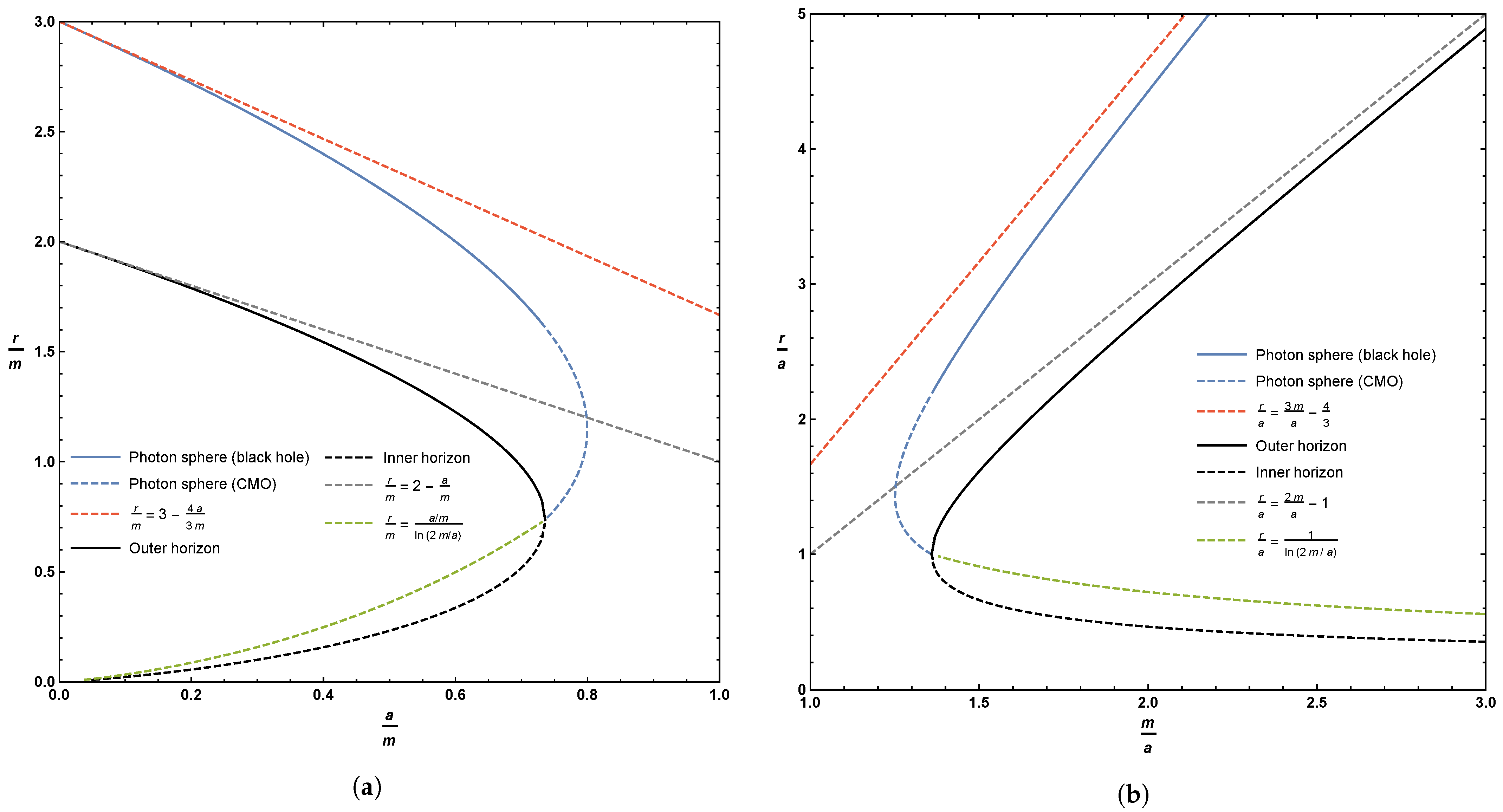
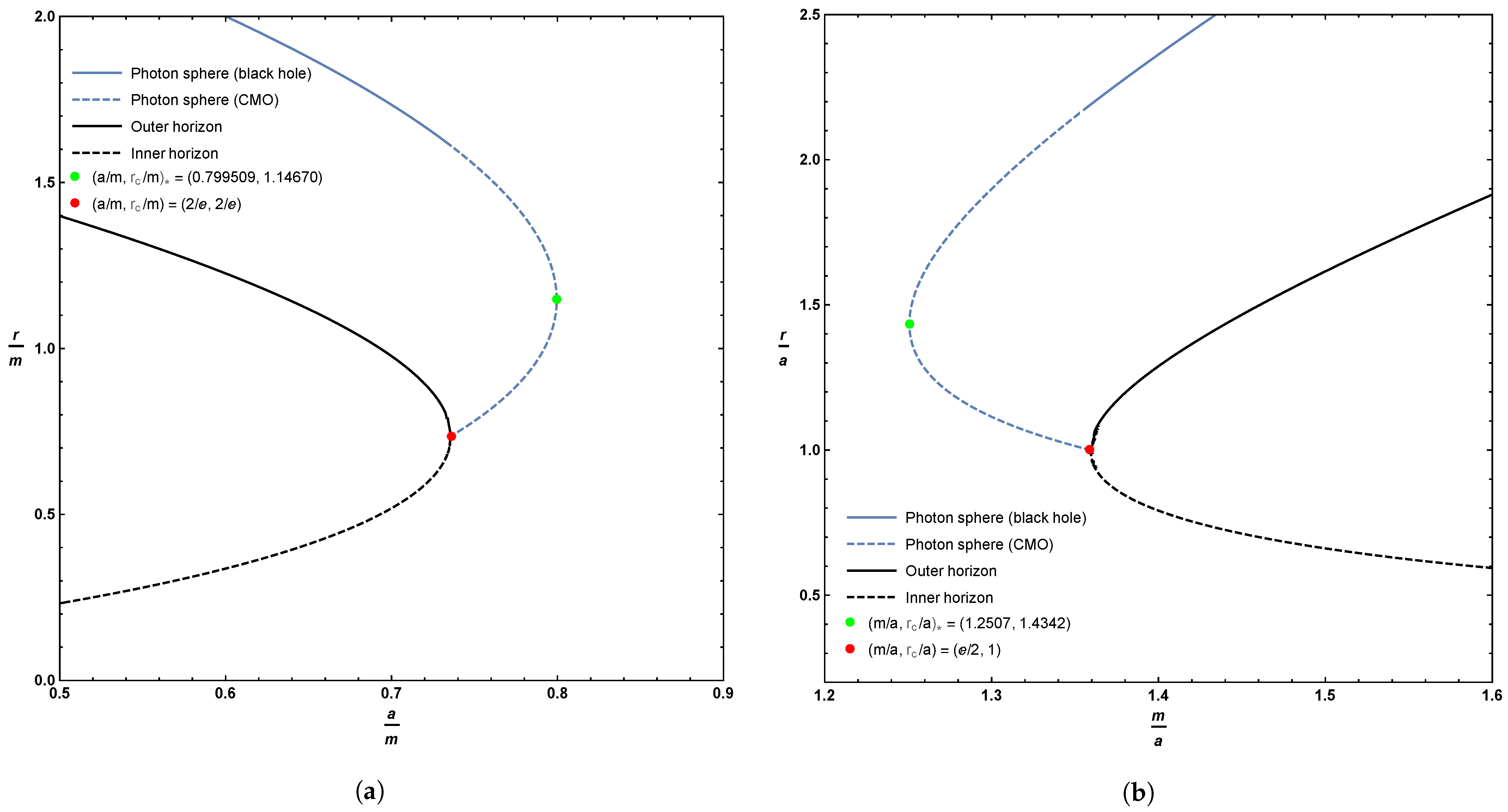
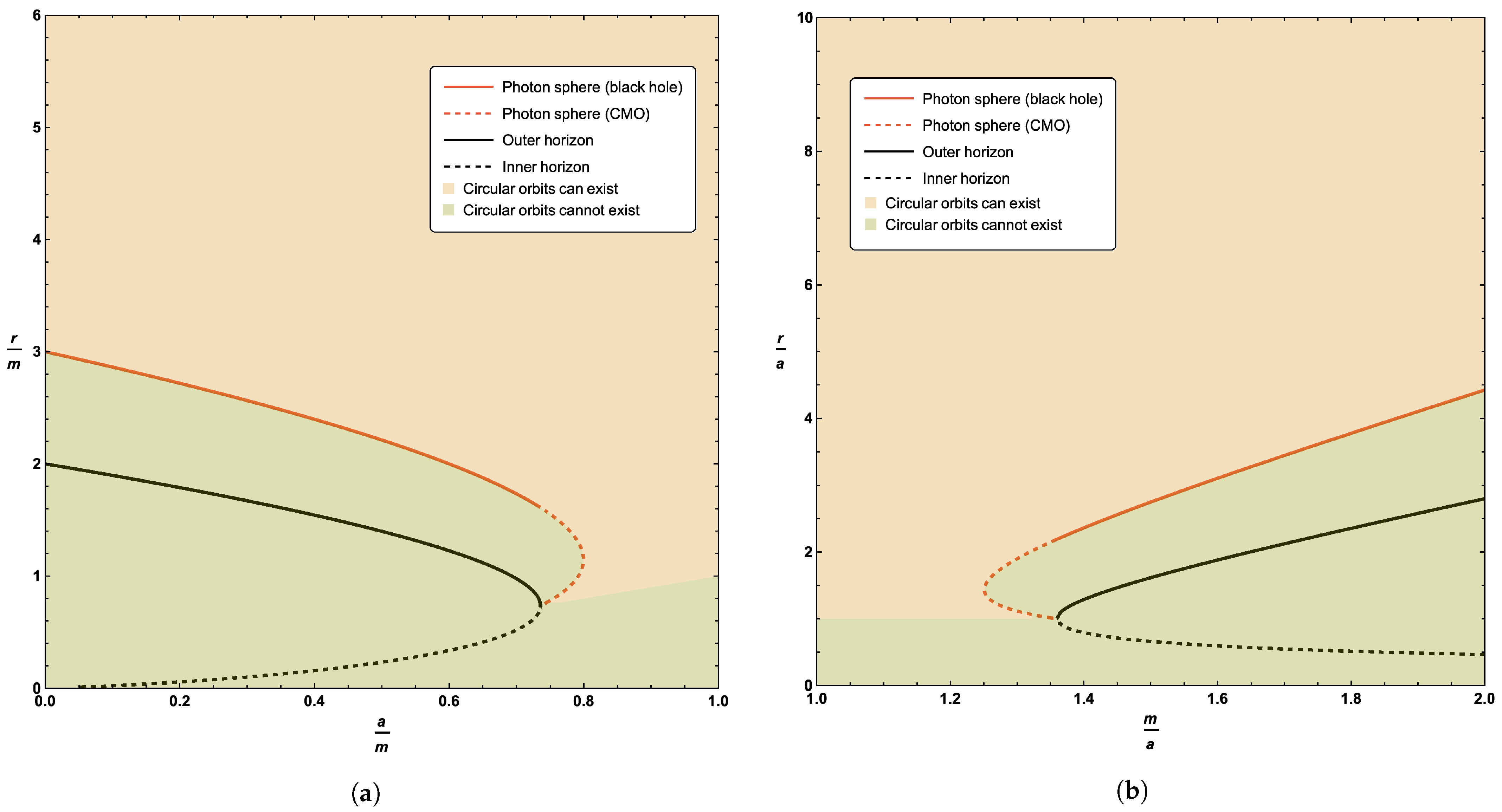
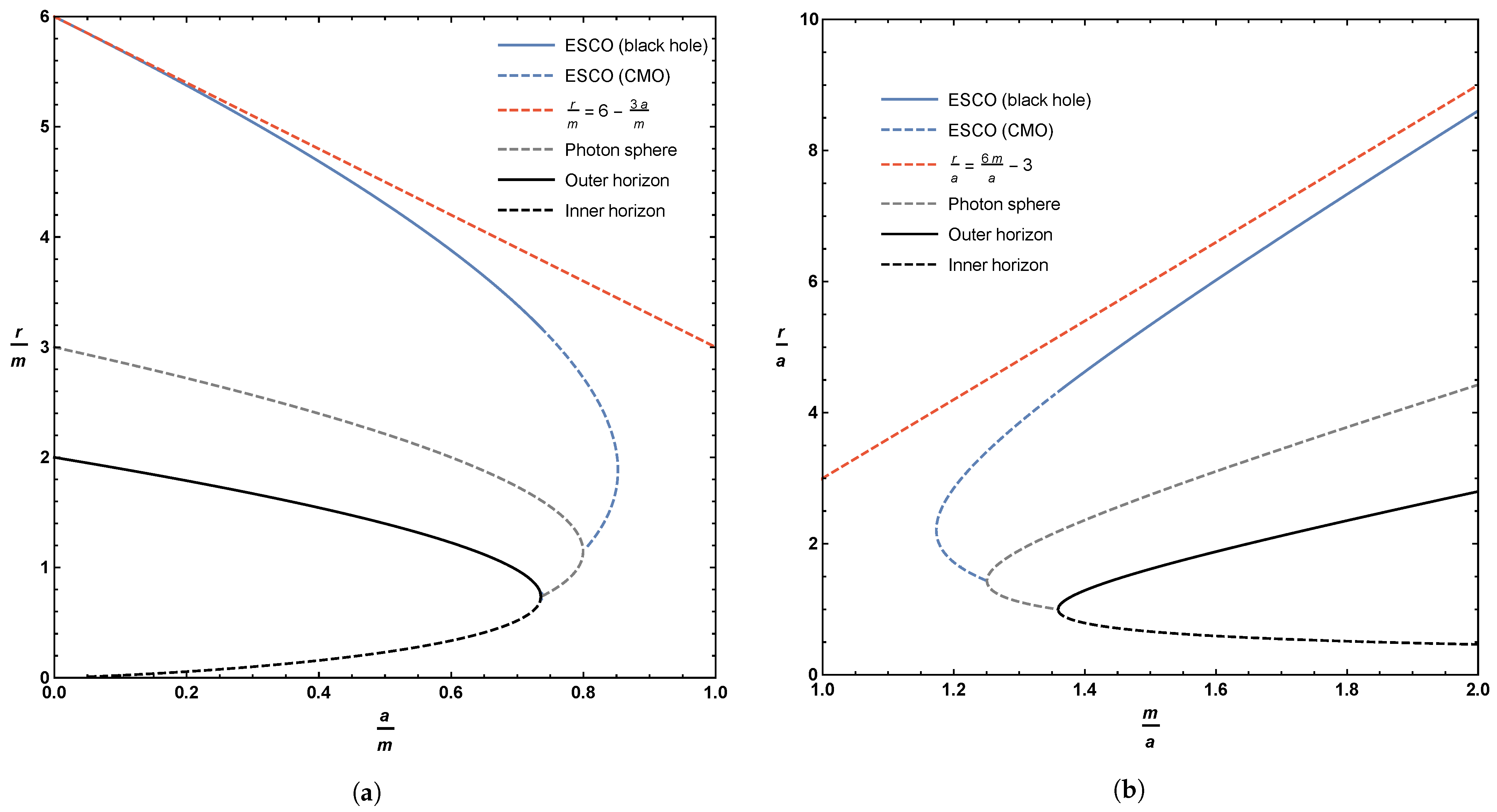
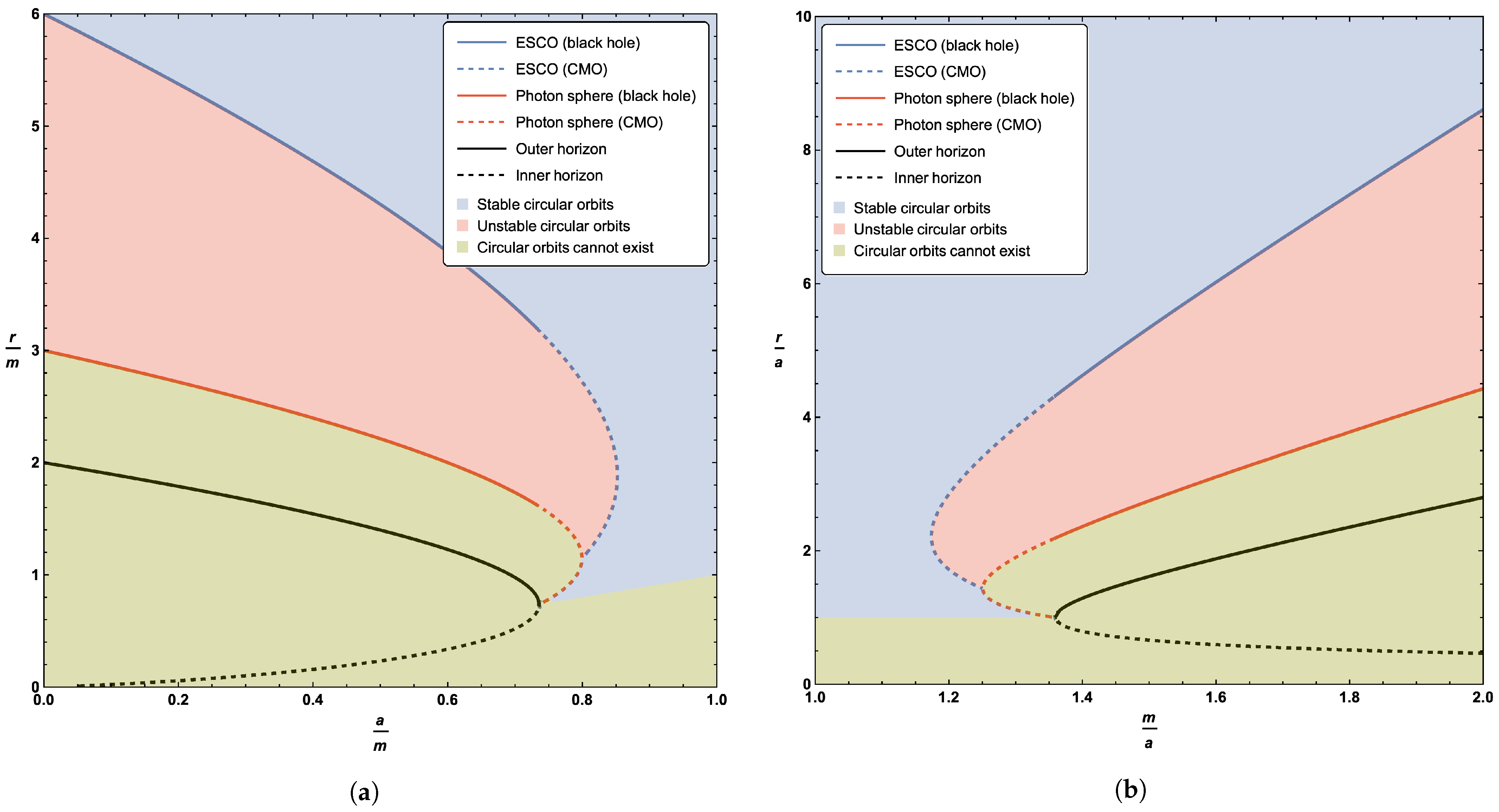
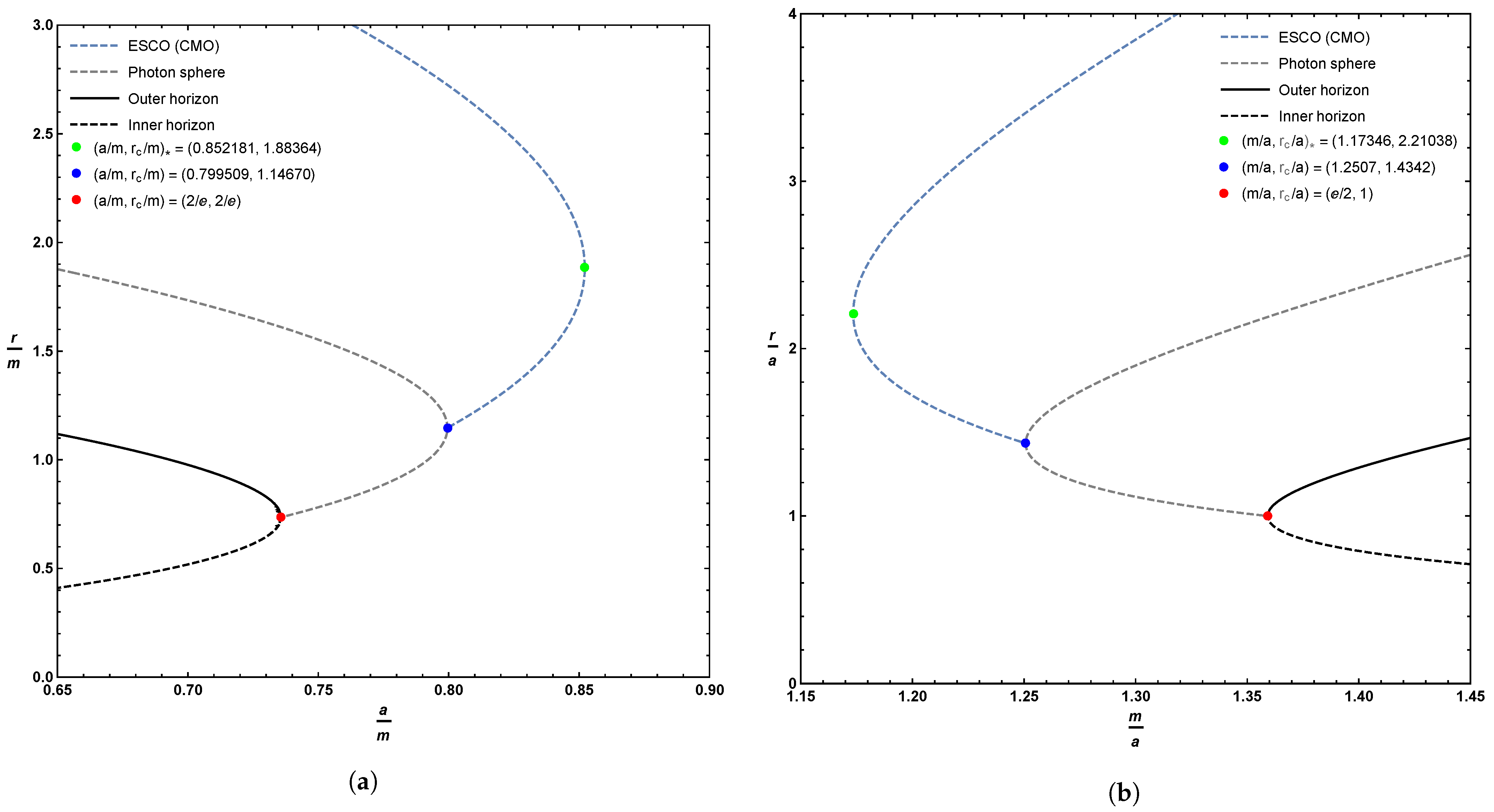
Publisher’s Note: MDPI stays neutral with regard to jurisdictional claims in published maps and institutional affiliations. |
© 2020 by the authors. Licensee MDPI, Basel, Switzerland. This article is an open access article distributed under the terms and conditions of the Creative Commons Attribution (CC BY) license (http://creativecommons.org/licenses/by/4.0/).
Share and Cite
Berry, T.; Simpson, A.; Visser, M. Photon Spheres, ISCOs, and OSCOs: Astrophysical Observables for Regular Black Holes with Asymptotically Minkowski Cores. Universe 2021, 7, 2. https://doi.org/10.3390/universe7010002
Berry T, Simpson A, Visser M. Photon Spheres, ISCOs, and OSCOs: Astrophysical Observables for Regular Black Holes with Asymptotically Minkowski Cores. Universe. 2021; 7(1):2. https://doi.org/10.3390/universe7010002
Chicago/Turabian StyleBerry, Thomas, Alex Simpson, and Matt Visser. 2021. "Photon Spheres, ISCOs, and OSCOs: Astrophysical Observables for Regular Black Holes with Asymptotically Minkowski Cores" Universe 7, no. 1: 2. https://doi.org/10.3390/universe7010002
APA StyleBerry, T., Simpson, A., & Visser, M. (2021). Photon Spheres, ISCOs, and OSCOs: Astrophysical Observables for Regular Black Holes with Asymptotically Minkowski Cores. Universe, 7(1), 2. https://doi.org/10.3390/universe7010002





